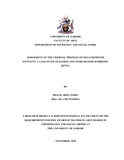| dc.description.abstract | Homicide is arguably the most horrifying public offence, it is the only crime that creates finality to human life. The impact of murder goes far beyond the loss of life and might create an environment of ambiguity and fear among the public. This study sought to assess the criminal profiles of convicted male homicide convicts at Kamiti and Nyeri Maximum Prisons situated within Nairobi and Nyeri Counties respectively. The study rationale was to establish the demographics, socio-economic characteristics of the male homicide convicts, establish factors that may have propelled them to commit homicide, assess their modus operandi, establish their criminal history and establish victim-offender relationships of convicted male homicide offenders. The study adopted a cross-sectional survey design that employed both qualitative and quantitative data collection techniques, systematic sampling method was used that involved 88 convicted homicide inmates selected from Kamiti Maximum Prison and 22 from Nyeri Maximum Prison. The study also conducted a cross-comparison of the major study variables between the two maximum prisons. Both primary and secondary approaches of data collection were used for the study. Documentary sources from prison records also helped in supplying secondary data. The main research instrument for collecting data in the study was semi-structured questionnaires. The data was processed and analyzed by descriptive qualitative and quantitative techniques using the statistical packages for the social sciences (SPSS V 21) and MS Excel.
The study found that most of the homicide convicts were youthful people, had low education and had Substance abuse problems. Further, males were the predominant victims of homicide and were more likely to be murdered in urban areas than in rural areas. Additionally, homicide was more likely to be committed during the night than during the day. The study further found that Nairobi County was the County with the highest homicide rates. Guns and knives were found to be the most prevalent weapons of homicide in Nairobi and Kajiado Counties. The study further established that homicide victims were mostly related or well known to the offenders. Moreover, provocation among relatives was a predominant factor propelling the commission of homicide. In addition, some homicide offenders in the study were first-time offenders with no previous criminal history.
The study recommends that the government should roll out a program to ensure all pupils who complete primary education get to join secondary schools or vocational training schools. Further, the government through NACADA (National Campaign Against Drug Abuse), non-governmental and religious organizations to roll out awareness campaigns on substance abuse. Additionally, the Kenyan government needs to address the risk of illegal Firearms through regulating the proliferation of small arms mostly in urban centers, particularly in Nairobi County where guns were most prevalent. The government should also Promote and facilitate an increase in night patrols by law enforcement officers in the urban areas since homicide is mostly committed at night. Finally, the study recommends further research on criminal profiles of female homicide convicts in Kenya, the relationship between substance abuse and the increase in homicide cases in Kenya and a study on criminal profiles of male convicted homicide offenders in the other five maximum prisons namely; Shimo la Tewa, Naivasha, Kodiaga. Manyani and Kibos maximum prisons in Kenya. | en_US |



